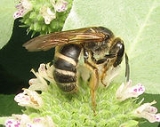
Lasioglossum
Encyclopedia
The sweat bee genus
Lasioglossum is the largest of all bee genera, containing over seventeen hundred species in numerous subgenera worldwide. They are highly variable in size, coloration, and sculpture; among the more unusual variants, some are cleptoparasites, some are nocturnal, and some are oligolectic. Most Lasioglossum nest in the ground, but some species nest in rotten logs.
The genus Lasioglossum can be divided into two informal series based on the strength of the distal veins of the forewing . The Lasioglossum series (or strong-veined Lasioglossum) is mostly composed of solitary or communal species. Two possible exceptions are Lasioglossum aegyptiellum and Lasioglossum rubricaude, both of which show signs of division of labour indicative of eusociality.
The Hemihalictus series (or weak-veined Lasioglossum) includes species with a wide range of sociality . The Hemihalictus series is composed of species which are solitary, communal, semisocial, primitively eusocial, cleptoparasitic, or socially parasitic. Eusocial species may have small colonies with only one or a few workers or large colonies with dozens of workers. The largest colony sizes occur in Lasioglossum marginatum which forms perennial colonies lasting five or six years, with hundreds of workers.
List of subgenera (modified from Michener's Bees of the World):
Lasioglossum series: Australictus, Callalictus, Chilalictus, Ctenonomia, Echthralictus, Glossalictus, Homalictus, Lasioglossum s. str., Leuchalictus, Oxyhalictus, Parasphecodes, Pseudochilalictus, Rubrihalictus, Urohalictus.
Hemihalictus series: Acanthalictus, Austevylaeus, Dialictus, Evylaeus, Hemihalictus, Paradialictus, Sellalictus, Sphecodogastra, Sudila.
Subgeneric classification of Lasioglossum remains controversial, with disagreement among experts on the number and extent of subgenera.
Two of the better-known species are the Europe
an Lasioglossum malachurum and the North American species Lasioglossum zephyrum
.
References:
Genus
In biology, a genus is a low-level taxonomic rank used in the biological classification of living and fossil organisms, which is an example of definition by genus and differentia...
Lasioglossum is the largest of all bee genera, containing over seventeen hundred species in numerous subgenera worldwide. They are highly variable in size, coloration, and sculpture; among the more unusual variants, some are cleptoparasites, some are nocturnal, and some are oligolectic. Most Lasioglossum nest in the ground, but some species nest in rotten logs.
The genus Lasioglossum can be divided into two informal series based on the strength of the distal veins of the forewing . The Lasioglossum series (or strong-veined Lasioglossum) is mostly composed of solitary or communal species. Two possible exceptions are Lasioglossum aegyptiellum and Lasioglossum rubricaude, both of which show signs of division of labour indicative of eusociality.
The Hemihalictus series (or weak-veined Lasioglossum) includes species with a wide range of sociality . The Hemihalictus series is composed of species which are solitary, communal, semisocial, primitively eusocial, cleptoparasitic, or socially parasitic. Eusocial species may have small colonies with only one or a few workers or large colonies with dozens of workers. The largest colony sizes occur in Lasioglossum marginatum which forms perennial colonies lasting five or six years, with hundreds of workers.
List of subgenera (modified from Michener's Bees of the World):
Lasioglossum series: Australictus, Callalictus, Chilalictus, Ctenonomia, Echthralictus, Glossalictus, Homalictus, Lasioglossum s. str., Leuchalictus, Oxyhalictus, Parasphecodes, Pseudochilalictus, Rubrihalictus, Urohalictus.
Hemihalictus series: Acanthalictus, Austevylaeus, Dialictus, Evylaeus, Hemihalictus, Paradialictus, Sellalictus, Sphecodogastra, Sudila.
Subgeneric classification of Lasioglossum remains controversial, with disagreement among experts on the number and extent of subgenera.
Two of the better-known species are the Europe
Europe
Europe is, by convention, one of the world's seven continents. Comprising the westernmost peninsula of Eurasia, Europe is generally 'divided' from Asia to its east by the watershed divides of the Ural and Caucasus Mountains, the Ural River, the Caspian and Black Seas, and the waterways connecting...
an Lasioglossum malachurum and the North American species Lasioglossum zephyrum
Lasioglossum zephyrum
Lasioglossum zephyrum is a sweat bee of the family Halictidae, found in the U.S. and Canada. It is known to be a somewhat antisocial species, and it has been shown to have a tendency to remain solitary. The species nests in underground burrows...
.
References:

